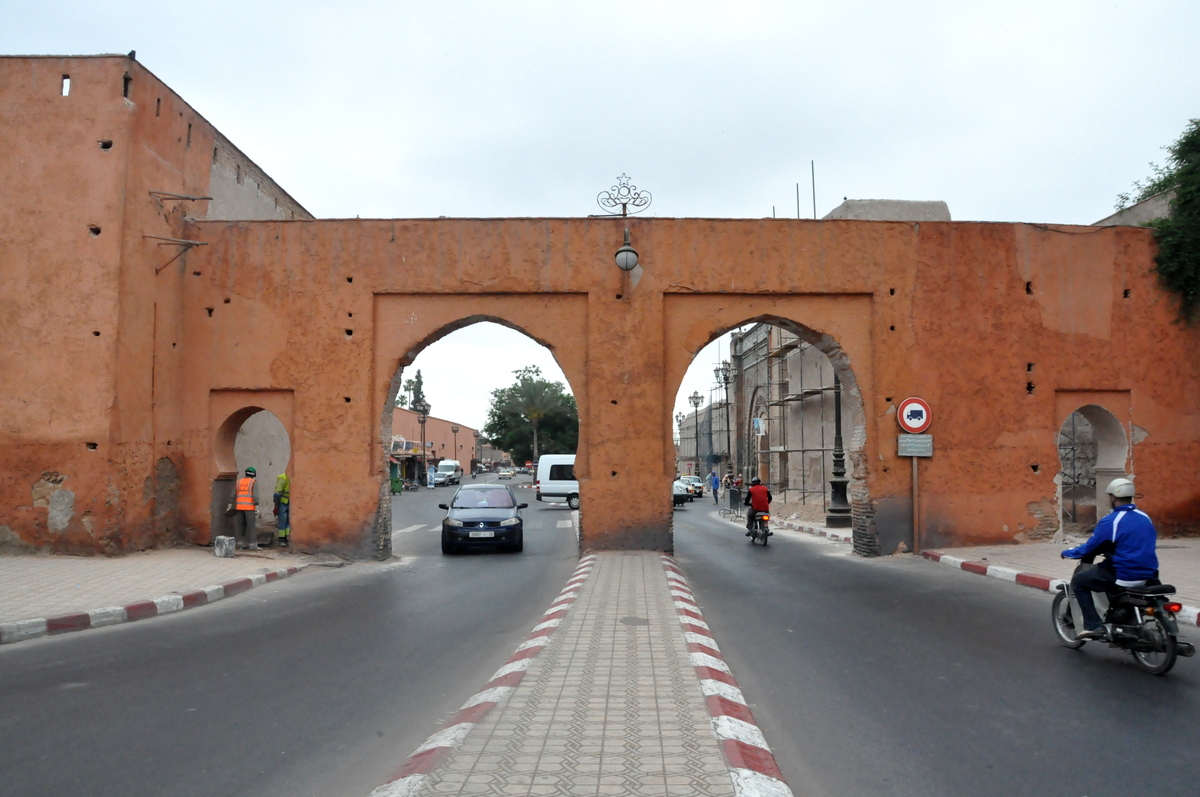Bab er Robb on:
[Wikipedia]
[Google]
[Amazon]
 Bab er Robb () is a southern city gate in the historic
Bab er Robb () is a southern city gate in the historic
 The gate is located near
The gate is located near
medina
Medina,, ', "the radiant city"; or , ', (), "the city" officially Al Madinah Al Munawwarah (, , Turkish: Medine-i Münevvere) and also commonly simplified as Madīnah or Madinah (, ), is the second-holiest city in Islam, and the capital of the ...
of Marrakech, Morocco
Morocco (),, ) officially the Kingdom of Morocco, is the westernmost country in the Maghreb region of North Africa. It overlooks the Mediterranean Sea to the north and the Atlantic Ocean to the west, and has land borders with Algeria t ...
.
Location
Bab Agnaou
Bab Agnaou (; ; sometimes transliterated as Bab Agnaw) is one of the best-known gates of Marrakesh, Morocco. Its construction is attributed to the Almohad caliph Abu Yusuf Ya'qub al-Mansur and was completed around 1188 or 1190.
The gate was the ...
and the Kasbah district. It leads to the roads that lead to the mountain towns of Amizmiz and Asni
Asni ( ar, أسني) is a small town in the foothills of the High Atlas mountains near Marrakesh, Morocco
Morocco (),, ) officially the Kingdom of Morocco, is the westernmost country in the Maghreb region of North Africa. It overloo ...
.
Historical background
While some historians believe the gate to be ofAlmohad
The Almohad Caliphate (; ar, خِلَافَةُ ٱلْمُوَحِّدِينَ or or from ar, ٱلْمُوَحِّدُونَ, translit=al-Muwaḥḥidūn, lit=those who profess the unity of God) was a North African Berber Muslim empire fou ...
origin (specifically under Ya'qub al-Mansur
Abū Yūsuf Yaʿqūb ibn Yūsuf ibn Abd al-Muʾmin al-Manṣūr (; c. 1160 – 23 January 1199 Marrakesh), commonly known as Yaqub al-Mansur () or Moulay Yacoub (), was the third Almohad Caliph. Succeeding his father, al-Mansur reigned from 11 ...
) due to its location relative to the Almohad Kasbah
A kasbah (, also ; ar, قَـصَـبَـة, qaṣaba, lit=fortress, , Maghrebi Arabic: ), also spelled qasba, qasaba, or casbah, is a fortress, most commonly the citadel or fortified quarter of a city. It is also equivalent to the term ''alca ...
, architect and specialist of Moroccan architecture Quentin Wilbaux more recently argued that its location in the wider schema of the city suggests it was an original Almoravid
The Almoravid dynasty ( ar, المرابطون, translit=Al-Murābiṭūn, lit=those from the ribats) was an imperial Berber Muslim dynasty centered in the territory of present-day Morocco. It established an empire in the 11th century that ...
gate. Both of them believe that Bab Neffis, another gate described in historical sources and named after the nearby Neffis (or N'fis) River, was most likely another name for the same gate. The word ''Robb'' or ''Rubb'' refers to a type of cooked wine whose vineyards were cultivated along the Neffis River and thus imported and regulated through this gate. A water basin measuring approximately 70 by 40 metres once existed outside this gate, in an area now covered by a cemetery, and was used for swimming practice.
Architectural design
Bab er-Robb is one of the most unusual gates in the city, and the only one to be located in an angle or corner of the walls. The main structure of the gate is a bastion inside which a bent passage enters from the north, performs a 180-degree turn, and then exits again to the north. Today, the walls in the area have been moved around the gate's bastion such that both entrances of the gate, which face north, open inside the city walls. This obscures its original role as a passage in and out of the city. However, when the gate was studied by French scholars in 1912 the city wall had a different configuration: rather than attaching to the side of the gatehouse it attached to the middle of the gate's northern facade, between its two doorways, such that the left or eastern doorway was outside the city wall while the right or western one was inside the walls. Since both entrances still faced north, this meant that the outer entrance faced away from the countryside and towards the city walls; as a result, travelers coming from the south, outside the city, had to walk all the way around to the other side of the bastion in order to enter it from the north. Because of this uncharacteristic configuration, and based on comparisons with other gates of the city, Wilbaux has hypothesized that the city's ramparts in this area were altered and moved around the gate such that the entrances were reversed: the eastern doorway, which was the outer entrance in 1912, was originally located inside the city walls, while the western doorway (the inner entrance in 1912) was originally outside the city walls. This way, the bastion of the gate straddled the city wall and its design was equivalent to the original configuration of Bab Aghmat, the other southern gate of the city.References
{{Marrakesh Buildings and structures completed in the 12th century Almohad architecture Gates of Marrakesh Almoravid architecture